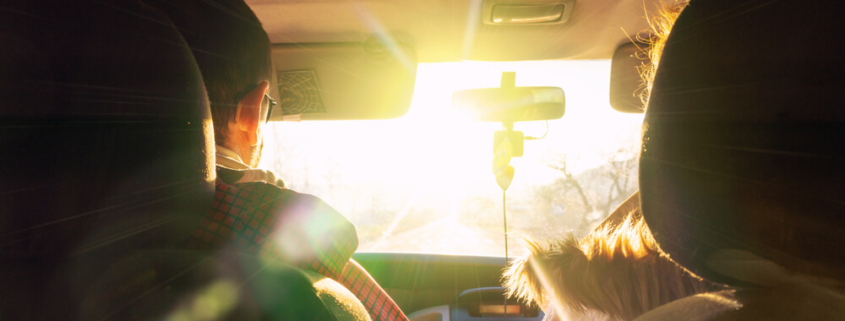The Dangers of Sun Glare Accidents
During the fall and winter months when the days get shorter, the possibility of sun glare while driving greatly increases. We have all experienced it from time to time; you are driving to or from work and everything is fine – until a blast of blinding bright sunlight pierces through your windshield. Suddenly, you can hardly see anything in front of you, and all you can do is hope that you do not hit anything.
Sun glare is a contributing factor in numerous auto accidents each year. The official number (according to the National Highway Transportation Safety Administration) is just a few hundred, but AAA and other organizations believe the number is much higher. Often times, sun glare is not listed as the cause of an accident on the police report, even though it still may have played a role.
A 20-year study conducted by the National Institute of Health (NIH) helps shed some additional light on this issue. The study of more than 11,000 life-threatening motor vehicle crashes from 1995 to 2014 examined the causes of hospitalizations from these crashes. It found that bright sunlight was present in roughly a third of all crashes that happened during the daylight hours, which is a strong indication that sun glare is far more dangerous than most people believe.
Am I Liable for a Sun Glare Accident?
When someone causes a crash that happens because they were blinded by bright sunlight, they might naturally wonder whether or not they are liable for damages. After all, sunlight is an “act of God”, so that would be a factor that is beyond the control of the driver, right? On the surface, this may seem like it could be a viable argument. But unfortunately for the driver who was blinded by sun glare, it is not.
It may be true that the sun shining is a natural event, but it is not an “extraordinary” event that would fall under the category of an “act of God”. An “act of God” is an unpredictable and uncontrollable event; such as an earthquake, mudslide, or a deer dashing in front of your vehicle while it is in motion. These are events that do not happen every day, and it is very hard to know when and where they will occur.
Bright sunlight, by contrast, is not unusual or unpredictable. The sun rises every morning and sets every evening like clockwork, and it not difficult to find out what time of the day these events will occur. We also know that, during certain times of the year, there is a greater chance of encountering sun glare when we drive east in the morning and west in the late afternoon.
As motorists, we have a duty of care to those we share the roads with. This means taking reasonable steps to operate our vehicle in a safe manner, which includes taking various precautions to prepare for the possibility of bright sunlight.
Ways to Prevent Sun Glare Accidents
There are several things we can do to better handle bright sunlight when we drive:
- Keep your Windshield Clean and Clear: If you have marks or streaks on your windshield, or if you have clutter on your dashboard, it will make it even more difficult to see when the sun shines brightly into your vehicle. Before you start your trip, make sure your windshield is clean and clear on both the outside and the inside. Fill up with plenty of washer fluid and replace your windshield wipers if needed to help avoid streaks while you drive.
- Wear Polarized Sunglasses: Whenever you drive during the day, you should have a good pair of sunglasses to help minimize the effects of bright sunlight. Polarized sunglasses are best for this purpose.
- Utilize your Sun Visors: Be sure to turn your sun visors to the side when needed to block out bright glare. You may also want to consider purchasing sun visor extenders to give you extra protection.
- Drive Slowly and Carefully: As we all know, bright sunlight while driving makes it really hard to see what is in front of you. When the glare of the sun comes through your windshield, be sure to slow down and allow plenty of space between you and other vehicles, bicycles, and pedestrians.
- Avoid Distractions: Texting while driving and other forms of distracted driving are always dangerous, and this is particularly true when you are dealing with sun glare.
- Adjust your Route and Drive Time: Sometimes, just a small change in the time you drive or the route you take can significantly reduce the amount of time you have to spend staring at the sun. Consider any adjustments you may be able to make to your schedule that will allow you to accomplish this.
Injured in a Sun Glare Accident? Speak with an Experienced Auto Accident Lawyer
Despite your best efforts, you cannot control external factors on the road, such as the negligence of other drivers. If you or someone close to you has been injured in a motor vehicle crash that was the fault of another party, you deserve to be fully compensated. Insurance companies will do everything they can get away with to pay out as little as possible for your injuries. And for this reason, you need a strong legal advocate in your corner fighting hard for every dollar of compensation you are entitled to.
At Bailey, Javins, and Carter L.C., we are here to help! Call our office today at (800) 497-0234 or (800) 296-6979 or message us online to schedule a free consultation with one of our skilled attorneys.




